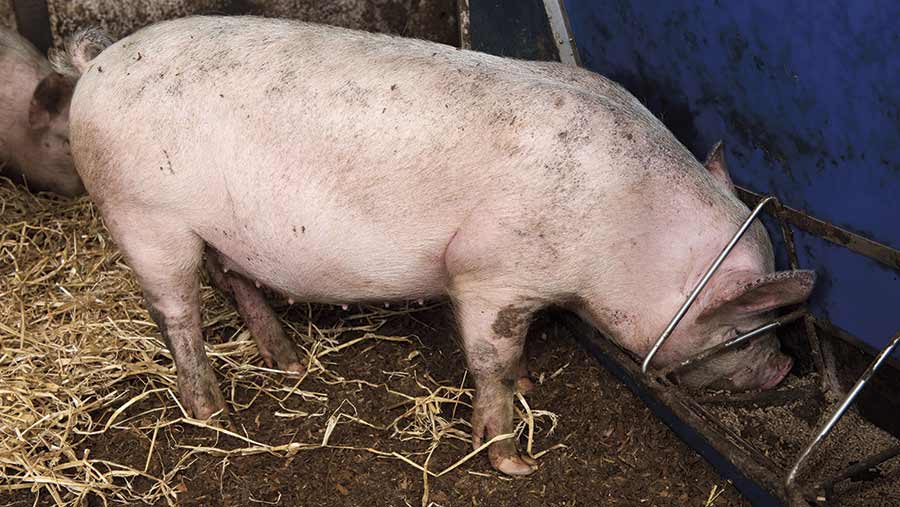Rapeseed meal could give pig finishers more flexibility
 © FLPA/Rex/Shutterstock
© FLPA/Rex/Shutterstock Rapeseed meal could be used to replace soya bean meal entirely as a cheaper and more sustainable alternative source of protein in finisher pig diets, scientists have discovered.
While rapeseed meal has been traditionally limited to 15% of a finishing pig’s diet, researchers have found the proportion can be raised to 25% without the animal’s growth or performance being affected.
It means farmers could reduce their reliance on imported protein and potentially reduce their feed costs, thanks to a home-grown alternative to soya bean meal.
See also: Cost-effective alternative to soya
The findings came from a study by scientists at the University of Nottingham and SRUC in Edinburgh, who investigated whether advice on the limits of feeding rapeseed meal to pigs was outdated.
Studies in Canada had found that higher levels of rapeseed meal could be used in weaner pig diets without reducing performance, and researchers wanted to see whether modern UK rape varieties could be used in a similar way.
Research findings
Carried out on behalf of AHDB Cereals, the study involved 96 grower and finisher pigs split across 16 same-sex pens in two batches.
The pigs were given either a control diet, based on soya bean meal, or a diet of 5%, 15% or 25% rapeseed meal made of one of two common UK rape varieties: DK Cabernet or PR46W21.
Leftover feed was weighed so that intake could be measured, while pigs were also weighed at regular intervals to track growth.
The study found that gradually exchanging soya bean meal for 25% rapeseed meal had no impact on the performance of finisher pigs.
“There’s an unwritten rule that we shouldn’t go higher than 10%-15% of rapeseed meal in finisher pig diets, but that isn’t the case,” says Jos Houdijk, professor of animal nutrition and health at SRUC and one of the scientists behind the study.
“People think from earlier studies that [increasing the proportion] leads to a reduction of intake because rapeseed meal tastes bitter, but varieties have moved on.”
Prof Houdijk says the two rapeseed varieties used in the trial were selected on the basis of a previous study into the palatability and nutritional value of different rapeseed meal for broilers.
Both rapeseed meals had less protein and lysine than soya bean meal (35% of protein and lysine compared with 48%), but had higher energy levels, meaning less wheat needed to be added into the meal mix.
“We thought the pigs could deal with higher levels of rapeseed meal without really affecting performance, relative to 5% and 15%,” says Prof Houdijk. “The finisher pigs essentially said ‘bring it on’ – they grew just as well at 25% rapeseed meal without any soya.
“What’s more, in the diets with 25% rapeseed meal, we could reduce levels of wheat in the diet by 40%.”
Just as efficient
While it was a small-scale study, Prof Houdijk says results suggest rapeseed meal is just as efficient as soya bean meal, and the industry standard maximum of 15% could be lifted.
For grower pigs, however, the results were not as simple. “At 15% and 25% there was a reduction in intake and growth, but not in feed efficiency,” Prof Houdijk says.
“That suggests the younger pigs are more sensitive to rapeseed. It could be a taste issue, as rapeseed can be bitter, so a technical solution could be to add a masking flavour to younger pig diets.
“While care is needed when ramping up the inclusion of rapeseed meal in younger animals’ diets, this study is another example of how we can reduce reliance on imported soya,” he adds.
“We are in a situation where imports are becoming more and more expensive, and anything we can do to produced feed in the UK is a good thing.”
For farmers who home-mix feed, this could be an opportunity to revisit their formulations, while those who use a ready-mixed meal could talk to their suppliers about their feed composition, Prof Houdijk says.
“It’s unlikely farmers will grow their own rapeseed for feed, because it needs to be crushed for pigs to process it and crushing only takes place in large quantities. However, this is an opportunity for interested farmers to raise the discussion with suppliers.”
Understanding boundaries
Nigel Penlington, AHDB Pork head of knowledge exchange, says compounders have been using increased levels of rapeseed meal in recent years, but understanding where the boundaries are is vital to the sector.
“Anything that gives us an alternative to soya and other proteins gives more flexibility to producers,” he says. “If we have other ingredients, we can counteract price volatility – and it also adds value to the rapeseed crop.
“The levels used by compounders are a commercial decision, so research like this adds confidence that the potential is there: if we can push the boundaries, increase options and make better use of a recovered product, then that’s good for the industry and the environment.”
